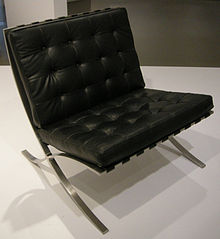Barcelona armchair
The Barcelona armchair (also known as MR90 ) is an armchair designed by the architect Ludwig Mies van der Rohe with Lilly Reich for the German pavilion at the 1929 World Exhibition in Barcelona. The approximately 75 × 75 × 75 cm armchair is one of his best-known and most successful furniture designs and is considered an icon of modernism.
Production history
The armchairs from the Barcelona Pavilion (1929)
The armchair was originally designed for the pavilion of the German Empire at the Exposició Internacional de Barcelona in 1929 as a seat for the Spanish royal couple. The construction of the crossing steel profiles is reminiscent of antique seating furniture such as B. the Curulian Chair . This is particularly noticeable in the stool, which was also designed for the pavilion.
The cushions of at least three white and at least two dark copies made for the pavilion were buttoned diagonally. They had nine straps for the seat cushion that ran from front to back and four horizontal straps for the back cushion. According to Mies van der Rohe, they were covered with glacé leather . The oldest surviving construction drawing dates from 1931 and already provides for eight vertical back straps. Therefore, no statement can be made from this drawing about the original construction of the metal frame of the Barcelona armchair from 1929. The unique pieces for the pavilion were presumably made by Carl Wilke in an art forge in Neukölln .
All copies from the pavilion have been lost. Modern armchairs made by Knoll were used for the reconstruction of the pavilion.
Production in Berlin (1930–34)
The first series of the armchair was manufactured from 1930 under the name MR90 by the Berliner Metallgewerbe Josef Müller company and from 1931 by its successor, the Bamberg Metallwerkstätten until 1934. The company produced in Lichtenrader Straße 33 in the Neukölln district. The armchair with a pigskin cover cost RM 520. The number of now vertical back straps varied between seven and nine in production.
The oldest surviving two armchairs from this production and also two copies in general are from the Tugendhat Villa (today in the archive of the Brno City Museum). Another surviving example is the armchair from the Grassi Museum in Leipzig (Inv.No. 72.35), which can be dated to 1933 based on an accompanying dated and signed drawing. Another copy is preserved from the estate of the art critic and collector James Johnson Sweeney, for whom Mies van der Rohe furnished an apartment in the 1930s.
Post war production
After the war, the chair was made by Gerry Griffin in Chicago for Mies van der Rohe . This variant was the first made of stainless steel and has sharper edges at the intersection of the base, so it differs from Mies van der Rohe's design. Mies van der Rohe used Griffin's chairs to furnish the buildings he designed in Chicago.
In 1948 Mies van der Rohe was able to win over the furniture manufacturers Florence and Hans Knoll for production by the Knoll company . Knoll did not manufacture the armchairs itself, but had them manufactured by medium-sized companies in various countries. The armchair in its original version was produced until 1950.
In 1950, Mies van der Rohe revised the design of the armchair, the frame of which now consisted of one piece of metal instead of several soldered pieces. In addition to this change, goat leather was switched to cow leather. Production of this new armchair began in 1950 for the Knoll company. In 1964 production was switched to stainless steel.
Barcelona furniture series
A glass table and a lounger were designed to go with the armchair and stool, and these are still in production today. While the table shows its formal affiliation via the crossed steel frame, the lounger uses the same principle of quilted leather as a cushion on tensioned straps.
Movie
- Design: the Barcelona armchair. Documentary, France, 2011, 26 min., Script and director: Anna-Célia Kendall, production: arte France, Center Pompidou , Steamboat Films, Lobster Films, series: Design, German first broadcast: March 30, 2014 by arte, summary ( Memento of April 9, 2014 in the web archive archive.today )
Web links
- Barcelona Chair at the manufacturer Knoll International (English)
- "It is almost easier to build a skyscraper." In: ruhrmentar.de, about the Barcelona chair
Individual evidence
- ^ Max Stemshorn: Mies & Schinkel. Schinkel's role model in the Mies van der Rohe plant . Ed .: Max Stemshorn. Wasmuth, Tübingen / Berlin 2002, ISBN 3-8030-0626-0 , p. 77 f .
- ↑ a b c d e f g h Friederike Deuerler: The “Barcelona Chair” by Ludwig Mies van der Rohe - a design classic from a joining point of view. In: Schweiß und Schneid 65 (2013) issue 9. Accessed on February 20, 2018 .
- ^ Vitra Design Museum: Collection. Retrieved February 20, 2018 .
- ↑ Der Baumeister: Journal for Architecture, Planning, Environment . tape 102 , 2005, pp. 62 .
- ↑ a b c d Pim Schelvis: The Barcelona Chair. The full story. (No longer available online.) In: barcelonachairshop.com. February 2, 2016, archived from the original on February 21, 2018 ; accessed on February 20, 2018 .
- ↑ Collection from the manufacturer. Accessed June 5, 2019 .
